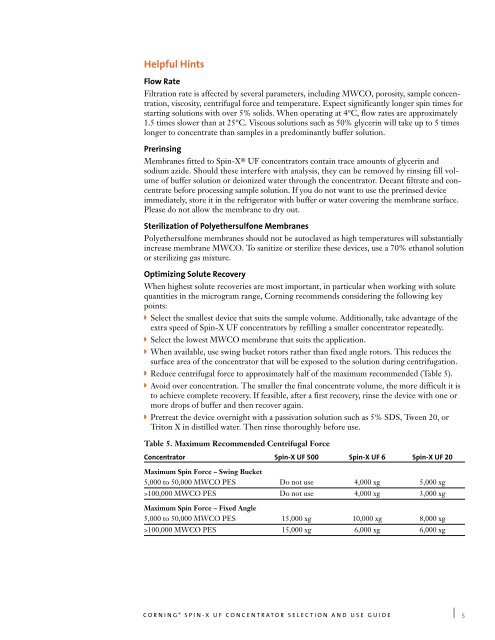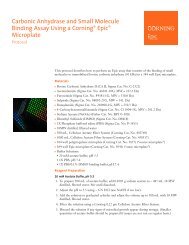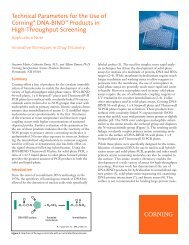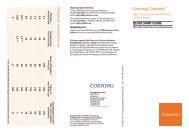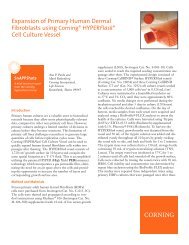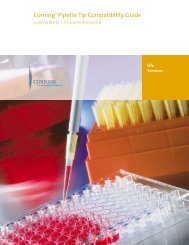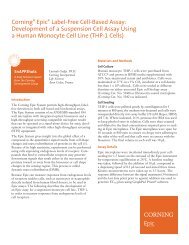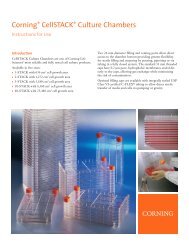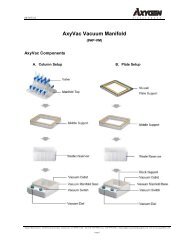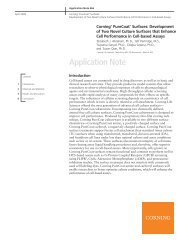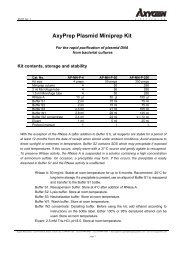Spin-X UF Concentrator Selection and Use Guide - Corning ...
Spin-X UF Concentrator Selection and Use Guide - Corning ...
Spin-X UF Concentrator Selection and Use Guide - Corning ...
Create successful ePaper yourself
Turn your PDF publications into a flip-book with our unique Google optimized e-Paper software.
Helpful HintsFlow RateFiltration rate is affected by several parameters, including MWCO, porosity, sample concentration,viscosity, centrifugal force <strong>and</strong> temperature. Expect significantly longer spin times forstarting solutions with over 5% solids. When operating at 4°C, flow rates are approximately1.5 times slower than at 25°C. Viscous solutions such as 50% glycerin will take up to 5 timeslonger to concentrate than samples in a predominantly buffer solution.PrerinsingMembranes fitted to <strong>Spin</strong>-X ® <strong>UF</strong> concentrators contain trace amounts of glycerin <strong>and</strong>sodium azide. Should these interfere with analysis, they can be removed by rinsing fill volumeof buffer solution or deionized water through the concentrator. Decant filtrate <strong>and</strong> concentratebefore processing sample solution. If you do not want to use the prerinsed deviceimmediately, store it in the refrigerator with buffer or water covering the membrane surface.Please do not allow the membrane to dry out.Sterilization of Polyethersulfone MembranesPolyethersulfone membranes should not be autoclaved as high temperatures will substantiallyincrease membrane MWCO. To sanitize or sterilize these devices, use a 70% ethanol solutionor sterilizing gas mixture.Optimizing Solute RecoveryWhen highest solute recoveries are most important, in particular when working with solutequantities in the microgram range, <strong>Corning</strong> recommends considering the following keypoints:◗ Select the smallest device that suits the sample volume. Additionally, take advantage of theextra speed of <strong>Spin</strong>-X <strong>UF</strong> concentrators by refilling a smaller concentrator repeatedly.◗ Select the lowest MWCO membrane that suits the application.◗ When available, use swing bucket rotors rather than fixed angle rotors. This reduces thesurface area of the concentrator that will be exposed to the solution during centrifugation.◗ Reduce centrifugal force to approximately half of the maximum recommended (Table 5).◗ Avoid over concentration. The smaller the final concentrate volume, the more difficult it isto achieve complete recovery. If feasible, after a first recovery, rinse the device with one ormore drops of buffer <strong>and</strong> then recover again.◗ Pretreat the device overnight with a passivation solution such as 5% SDS, Tween 20, orTriton X in distilled water. Then rinse thoroughly before use.Table 5. Maximum Recommended Centrifugal Force<strong>Concentrator</strong> <strong>Spin</strong>-X <strong>UF</strong> 500 <strong>Spin</strong>-X <strong>UF</strong> 6 <strong>Spin</strong>-X <strong>UF</strong> 20Maximum <strong>Spin</strong> Force – Swing Bucket5,000 to 50,000 MWCO PES Do not use 4,000 xg 5,000 xg>100,000 MWCO PES Do not use 4,000 xg 3,000 xgMaximum <strong>Spin</strong> Force – Fixed Angle5,000 to 50,000 MWCO PES 15,000 xg 10,000 xg 8,000 xg>100,000 MWCO PES 15,000 xg 6,000 xg 6,000 xgC O R N I N G ® S P I N - X U F C O N C E N T R A T O R S E L E C T I O N A N D U S E G U I D E5


